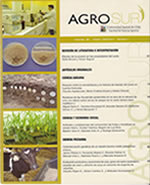Characterisation of Chilean hop (Humulus lupulus L.) ecotype Ranco in the Los Ríos Region
Main Article Content
Abstract
In recent years, southern Chile has experienced an increase in hop production mainly due to the boom of craft breweries. In the Los Ríos Region, several local hop ecotypes have been collected during the past ten years, with the Ranco ecotype being the most distributed and cultivated in the region. Therefore, it is urgent to provide producers and consumers with information that allows evaluating the potential contribution of hops in terms of differentiating the local production of craft beer and hop subproducts. The Ranco ecotype has a club shape with medium-sized dark green leaves, long side shoots in the upper part of the plant and anthocyanin pigmented stem. The cones are medium sized, concentrated in the upper third of the plant, revealing mid to late maturity. From an agronomic point of view, the plant shows vigorous and sturdy growth but is susceptible to downy mildew (Pseudopernospora humuli) and has low tolerance to mites (Tetranychus urticae). The average yield prospection of this ecotype ranges between 1,000 and 1,350 kg ha-1 in the Los Ríos Region and the cones are characterised by a predominant herbal and woody aroma. Although the hop cones analysed in this study presented a low percentage of bitter acids, significant amounts of polyphenols were detected in different parts of the plant which suggests a potential use in the food and cosmetic industry as well as the possible development of new regional beer varieties. In this study, the morphological and chemical characteristics of this novel hop ecotype are presented for the first time to contribute to the sustainable development of the brewing industry and added-value hop products in the Los Ríos Region.

